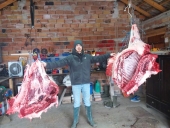




Xisca - pics! Dry subtropical Mediterranean - My project
However loud I tell it, this is never a truth, only my experience...
 3
3




Creating sustainable life, beauty & food (with lots of kids and fun)
 2
2




Jim Fry wrote:We skin them, the food value of the skin isn't that much.
Xisca - pics! Dry subtropical Mediterranean - My project
However loud I tell it, this is never a truth, only my experience...






List of Bryant RedHawk's Epic Soil Series Threads We love visitors, that's why we live in a secluded cabin deep in the woods. "Buzzard's Roost (Asnikiye Heca) Farm." Promoting permaculture to save our planet.




















List of Bryant RedHawk's Epic Soil Series Threads We love visitors, that's why we live in a secluded cabin deep in the woods. "Buzzard's Roost (Asnikiye Heca) Farm." Promoting permaculture to save our planet.




Wes Hunter wrote: Ashes seemed to help.
Bryant RedHawk wrote:Ashes in the water turn the water into an alkali bath which does help the hairs slip loose.
Wes Hunter wrote:With the first, the water cooled off way too quickly to get a good scald; with the second, we were able to maintain 160 degrees without half trying, which made for much more effective scraping.
Bryant RedHawk wrote:Boiling water is far to hot to get good hair slipping on any animal. I have done rabbits which would be similar to the OP's guinea pigs and 160 f water with a cup of hardwood ashes does a great job of getting the fur and underfur to slip fairly easily.
Wes Hunter wrote:3. We just used knives for scraping the hair off, holding the blade edge perpendicular to the skin.
Wes Hunter wrote:4. But interestingly, I found scalding and scraping to be much easier and a fair bit quicker than skinning. (A lot of people say it's more work to scald and scrape.) Not having to deal with slippery fat made a big difference.
Xisca - pics! Dry subtropical Mediterranean - My project
However loud I tell it, this is never a truth, only my experience...
















List of Bryant RedHawk's Epic Soil Series Threads We love visitors, that's why we live in a secluded cabin deep in the woods. "Buzzard's Roost (Asnikiye Heca) Farm." Promoting permaculture to save our planet.
 1
1




Wes Hunter wrote:5. Regarding "waste." Skinning an animal doesn't have to be wasteful or disrespectful, as the skins can be put to other uses (tanning is the obvious one; perhaps laying skins down as garden mulch?). Of course, nothing truly goes to waste anyway, but I know where you're coming from.
Xisca - pics! Dry subtropical Mediterranean - My project
However loud I tell it, this is never a truth, only my experience...
 1
1




Bryant RedHawk wrote:Xisca, let me know how it works out for you. I have tasted Guinea pig only once and it was delicious.
Redhawk
Xisca - pics! Dry subtropical Mediterranean - My project
However loud I tell it, this is never a truth, only my experience...
















List of Bryant RedHawk's Epic Soil Series Threads We love visitors, that's why we live in a secluded cabin deep in the woods. "Buzzard's Roost (Asnikiye Heca) Farm." Promoting permaculture to save our planet.




Xisca - pics! Dry subtropical Mediterranean - My project
However loud I tell it, this is never a truth, only my experience...
















List of Bryant RedHawk's Epic Soil Series Threads We love visitors, that's why we live in a secluded cabin deep in the woods. "Buzzard's Roost (Asnikiye Heca) Farm." Promoting permaculture to save our planet.




Xisca - pics! Dry subtropical Mediterranean - My project
However loud I tell it, this is never a truth, only my experience...
















List of Bryant RedHawk's Epic Soil Series Threads We love visitors, that's why we live in a secluded cabin deep in the woods. "Buzzard's Roost (Asnikiye Heca) Farm." Promoting permaculture to save our planet.




Xisca - pics! Dry subtropical Mediterranean - My project
However loud I tell it, this is never a truth, only my experience...




Bryant RedHawk wrote:The only time I ever skin a chicken is if I am harvesting it for meat and fly tying feathers. Otherwise I pluck, which takes me about 10 minutes.
When I hunt squirrels and rabbits I cut around the feet and pull the skin off. Squirrel and rabbit skins are salted to preserve them for fly tying needs.




Xisca - pics! Dry subtropical Mediterranean - My project
However loud I tell it, this is never a truth, only my experience...
















List of Bryant RedHawk's Epic Soil Series Threads We love visitors, that's why we live in a secluded cabin deep in the woods. "Buzzard's Roost (Asnikiye Heca) Farm." Promoting permaculture to save our planet.




Carbon Negative Stove plans available at:
https://www.carbonconsciouscreations.com
 1
1




Martijn Macaopino wrote:Xisca you have convinced me to try removing the hair next time I eat a guinea pig, I imagine this will also make it much nicer to roast them over some hot coals.
Do you remove the hair before or after gutting them?
Xisca - pics! Dry subtropical Mediterranean - My project
However loud I tell it, this is never a truth, only my experience...
 1
1




Xisca - pics! Dry subtropical Mediterranean - My project
However loud I tell it, this is never a truth, only my experience...



